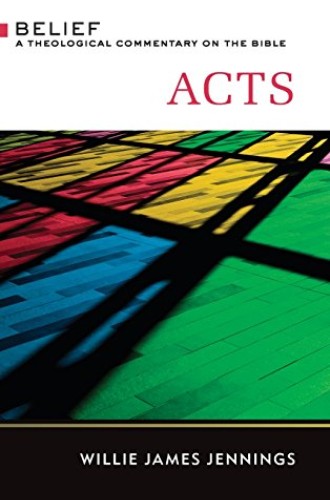Flesh and bones in an Acts commentary
Willie James Jennings writes about tangible things—bodies, incarceration, healing—with graceful language that’s hard to pin down.
“The visions that God gives are less about what we can capture in sight and sound and more about being captured, being drawn into the guiding hand of the Holy Spirit,” Willie James Jennings writes. He’s describing the revelation Ananias receives from God in Acts 9, but he might as well be describing his own book.
This commentary, which is the most recent addition to Westminster John Knox’s Belief: A Theological Commentary on the Bible series, is difficult to summarize. It addresses specific questions about bodies and relationships: what it means to live faithfully in the tension between diaspora and empire, how we negotiate the “social, economic, cultural, religious, gendered, and geographic” isolations in which we find ourselves, the way God’s desire for us draws us more deeply into life with one another. Jennings follows the author of Luke-Acts in emphasizing that the early church was made up of bodies—including bodies that were imprisoned, diseased, and otherwise marginalized. But he tends to write about these flesh-and-bones early Christian bodies in a lofty, ephemeral way. In other words, he writes like a theologian or a preacher. That’s the beauty—and occasionally the frustration—of this commentary, which reads differently from any other Acts commentary I’ve seen.
Commenting on the Ethiopian eunuch’s encounter with Philip in Acts 8, Jennings paraphrases the eunuch’s question in verse 34 as “Who is this person in pain and suffering, humiliation and shame?” He then explains: “The eunuch asked the right question, one that is like a prayer that God will answer. Now the body of God will be seen where no one would have imagined or dared to look, at the place of humiliation and pain and on a eunuch’s chariot.” Jennings warns against reading the Ethiopian as merely an instrument of evangelization or a symbol of mission. “God has come for the eunuch precisely in his difference and exactly in the complexities of his life. He matters, not because he is close to worldly power and thus a more appealing pawn. He simply matters, and he is being brought close. He will no longer be far from home.” Celebrating the eunuch’s baptism, Jennings writes with joy: “Faith found the water. Faith will always find the water. . . . The eunuch wants God as much as God wants him. They will wait no longer for each other. . . . God has broken the connection between identity and destiny, between definition and determination, and inserted a new trajectory.”





